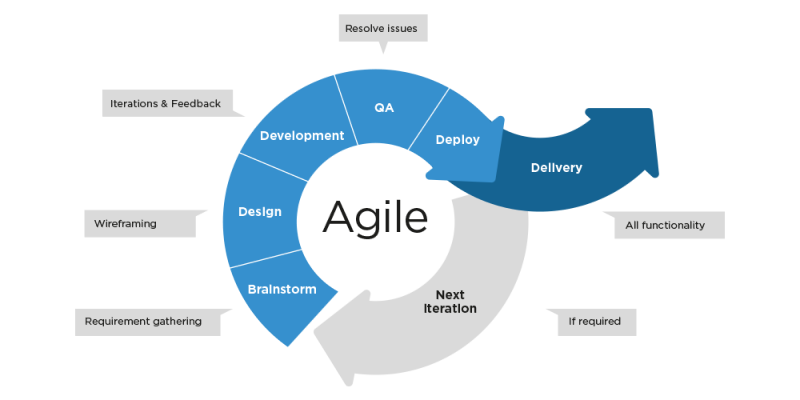Table Of Content
Discover How QA Testing Can Help You Develop a Better Software Product
Earlier, quality assurance testing was generally used as a post-development process to identify issues of a software. As a result of this development cycle, it became increasingly challenging to make timely fixes to a software, which was even more problematic when a software demanded drastic changes to it in order to fix its issues.
In search of a permanent fix to this inefficient approach to quality assurance, software houses have lately changed their development cycle to ensure that Quality Assurance goes hand in hand with software development methodologies. Presently, QA teams work with the software developers to make improvements on a regular basis; it’s a drastic shift from the previous method, based on agile methodology, which is why organizations that take this new approach towards managing software development projects are now known to operate in an Agile Environment.
This shared responsibility of delivering a high-quality end product, is what binds the software developers, operators, and testers together. However, despite their collective efforts, teams often struggle with Quality Assurance, because not everyone is on the same page when it comes to understanding what Quality Assurance Testing really is about. Because of how QA testing is so challenging, more and more software houses are now relying on external QA and Testing Services, instead of operating an in-house QA testing team.

What is QA Testing?
Quality Assurance testing, or QA testing, is a crucial aspect of software development and maintenance. It involves carefully evaluating the quality of software products and services to ensure that they meet customer expectations and requirements.
Using QA testing, organizations aim to produce consistent results by following a set of standardized procedures. Consequently, organizations have to ensure that the process of quality assurance is based on specific quality benchmarks for the purpose of maintaining the desired results.
There are many different aspects of Quality Assurance Testing, but some common activities include developing test plans, executing tests, and reporting results.
The Importance of Quality Assurance in Software Testing
The goal of most businesses is to deliver the finest product to their customers. Quality assurance testing helps to ensure that this goal is met by providing a systematic and independent way to assess the quality of software products and services.
However, this aim to deliver the finest end product is frequently sidelined in order to keep up with market demands, and to release the newest features as quickly as possible. In other words, businesses want to move fast, and they want to release new products and features before their competitors do.
Often when the software is developed it is hoped that the entire process from start to finish succeeds in its objective for a seamless development and design, with a streamlined distribution and delivery.
In case you’re a software developer yourself, you must have come across a software bug, unexpected downtime, or a poor user experience at some point in your life. Having experienced that, you must be well-aware of the fact that taking the time to do quality assurance testing can save you from some nerve wrecking problems and help you to deliver a product that meets, or even exceeds, customer expectations.
A common mistake that’s made even before beginning to work on a software, is to take an incorrect approach towards Quality Assurance. Many of our readers may be aware of what we mentioned earlier about QA testing being centered on delivering the best possible outcome to the customer; that it involves evaluating and analyzing the quality of software products and services, monitoring their performance and reliability, testing for bugs, and reporting results.
However, that’s only half of the story in a QA context; a software flaw isn’t just a bug. It might be anything that detracts from the end-user experience, from bad navigation to slow load speeds or unclear web content. The only method to reduce the danger of flaws while also improving end-user experience is to implement software and quality assurance testing throughout the whole development process.

How Do Quality Assurance and Software Testing Work Together?
Quality assurance testing is a process that should be integrated into the software development process from the very beginning. QA testers work with developers to ensure that quality standards are being met at every stage of the development process.
One of the benefits of this approach is that it can help to identify potential problems early on in the development process, before they become costlier to fix. QA testers provide developers with valuable feedback on potential bugs or areas of weakness, helping them to make improvements before the product is released.
Additionally, by working closely with developers throughout the entire development process, QA testers are able to gain a better understanding of how the process of software testing can be made more effective, and the role it plays in quality assurance. This helps them to become more efficient at their jobs and better equipped to provide valuable feedback and recommendations that can improve the overall quality of software products.
Overall, the relationship between QA testing and software development is a collaborative one, with both processes working together towards the common goal of delivering high-quality software products that meet customer expectations
What Skills Do I Need to Be a QA Tester?
To be a successful QA tester, you will need a combination of technical expertise and strong analytical skills. This often requires specialized training in software testing tools, as well as experience working in a fast-paced software development environment. Additionally, it is important to have good communication skills both with developers and with customers, as this will enable you to effectively understand and describe software issues, as well as provide valuable feedback on product improvements.
Some of the specific skills that may be required for a QA testing role include knowledge of various programming languages, proficiency with bug-tracking tools like JIRA or Bugzilla, and familiarity with test automation frameworks. Additionally, having an understanding of different software development methodologies, such as Agile or Waterfall, can be helpful in being able to quickly adapt to an organization’s existing testing processes.
Ultimately, the key to success as a QA tester is the ability to think critically and analyze software products from different perspectives in order to identify potential issues that may not be immediately obvious. With the right combination of technical expertise, analytical skills, and communication abilities, you can become a valuable member of any software development team and play an important role in ensuring that customer expectations are met with high-quality, reliable software products.
QA Testing Tools:
There are a variety of tools and technologies used in QA testing to help automate different aspects of the software development process. Some common examples include bug–tracking tools like JIRA or Bugzilla, automation frameworks like Selenium or QTP, and performance monitoring tools like New Relic.
These tools are essential for QA testers as they help automate many of the manual testing processes, enabling them to focus their efforts on analyzing software products and identifying potential issues. Additionally, using these tools can help to improve the accuracy and efficiency of the testing process, as well as providing valuable insights into trends and performance metrics that may not be otherwise easily visible.

Combine test automation and manual testing:
When developing a software, there are some quality guidelines and requirements that need to be followed. To check for compliance, the software goes through a strategic software testing plan, based on the software testing lifecycle.
That allows you to identify and rectify any and all issues before the software is released to the general public or use. Generally, a good software testing protocol includes aspects from both manual testing and automation testing, which allows development teams to benefit from the best of both techniques.
Let’s look at how this is accomplished, and why it can be of benefit to you.
What is Manual Testing?
Manual testing is the process of manually analyzing and evaluating software products to identify potential issues or flaws. This involves testing different aspects of a product, such as its usability, features, performance, and overall quality, in order to ensure that it meets customer requirements and expectations.
What Are the Benefits of Manual Testing?
There are several benefits to manual testing, including the ability to thoroughly and comprehensively evaluate a software product from multiple perspectives. This enables QA testers to effectively identify issues that may not be immediately obvious, such as usability problems or performance bottlenecks. Additionally, manual testing can help to ensure a higher degree of accuracy due to the fact that it is performed by humans rather than by automated tools.
What Are the Drawbacks of Manual Testing?
One of the main drawbacks of manual testing is that it can be time-consuming and inefficient, especially when compared to automated testing techniques. Additionally, manual testing may not be able to cover all aspects of a product, which could lead to potential issues being overlooked. For these reasons, many organizations are increasingly adopting test automation frameworks in order to help automate different aspects of the testing process.
What is Automation Testing?
Automation testing is the process of using specialized tools and software to automatically execute various tests on a software product. This can include functional testing, performance testing, regression testing, and other types of tests. Automation testing can help to improve the efficiency of the testing process by reducing the amount of time required to manually execute tests. Additionally, it can help to improve the accuracy of the testing process by reducing the potential for human error.
What Are the Benefits of Automation Testing?
There are several benefits to automation testing, including its ability to improve efficiency and accuracy while also reducing costs. Automation testing tools can help to significantly reduce the amount of time required to perform repetitive tasks, such as executing the same set of regression tests over and over again. They can also help to improve the accuracy of the testing process by reducing the potential for human error. Additionally, automation testing can help to save money by eliminating the need to hire expensive manual testers.
What Are the Drawbacks of Automation Testing?
One of the main drawbacks of automation testing is that it can be difficult to properly configure and maintain the test environment. Additionally, automation testing tools can be expensive, and they may not be able to cover all aspects of a product. Finally, automated tests may need to be frequently updated in order to keep pace with changes in the software product being tested.
How can Manual and Automated Testing be Combined?
One effective way to combine manual and automated QA testing is to use test automation tools for repetitive or simple tasks, while reserving more complex testing processes for manual testers. This can help to improve the efficiency of the testing process while also ensuring that all aspects of the software product are thoroughly evaluated.
Additionally, it is important to ensure that communication and collaboration between manual and automated testers is well-organized in order to avoid potential duplication of effort or confusion. Some other strategies that can be used to effectively combine manual and automated testing include utilizing test lab management software, QA dashboards or risk-based testing methodologies.
Overall, manual and automated testing are complementary approaches that can be used together to improve the overall quality of a software product. By combining these two approaches in a well-structured and organized way, organizations can help to ensure that their products meet user expectations and perform well in real-world settings. Ultimately, this can help to improve customer satisfaction and drive long-term success for the organization.
Incorporate Agile Methodologies into Software Testing Processes:

Agile methodologies are a set of principles and practices that can be used to improve the efficiency and effectiveness of software testing processes. These approaches focus on iterative, incremental development cycles that allow teams to respond quickly to changes in requirements or issues with the product being developed.
Some key features of agile methodologies include collaboration between team members, frequent testing and feedback loops, and the use of automation tools to streamline processes and reduce errors.
There are various ways that agile methodologies can be incorporated into software testing processes. One approach is to use an automated test framework such as Selenium or Appium, which allows testers to write automated tests using code rather than having to rely on manual methods. This can help to increase the speed and efficiency of QA testing by eliminating time-consuming tasks like scripting and creating test data sets.
Additionally, agile methodologies often incorporate techniques for continuous integration, which involves merging all development work into a master branch several times per day in order to identify issues early on in the development cycle.
Another key aspect of agile methodologies is regular communication between team members, which can help to ensure that everyone is aligned around shared goals and priorities. This may involve the use of team collaboration tools, such as chat applications or document sharing platforms, in order to facilitate real-time discussions and support cross-team coordination.
Overall, incorporating agile methodologies into software testing processes can help teams streamline their workflows and increase productivity while also ensuring high-quality results. By using these techniques consistently and systematically, organizations can stay competitive in today’s fast-paced technology landscape.
To Sum It Up:
Today, the importance of QA testing in software development has reached an all-time high. The earlier methods that failed to implement a streamlined process for the production and timely delivery of a product have been replaced by the incorporation of agile methodologies in software testing which has now become an integral part of the software development process.
FAQs
| What is QA testing? QA testing does not simply refer to fixing problems. Rather, it includes the creation of a guideline that helps maintain a quality standard so that everyone works in harmony and accordance with the rules. |
| What is meant by QA? Quality assurance is defined as “a component of quality management aimed at ensuring that quality criteria are met.” In short, management of quality provides confidence, both internally and externally, to the development team as well as the clients. |
| Is QA job easy? QA testing can be a very repetitive job, which is why QA testers require a lot of discipline to maintain a consistent attitude towards their job. This is caused due to the repetitive process of locating and reporting issues with the product, which can make it difficult to maintain focus. |
